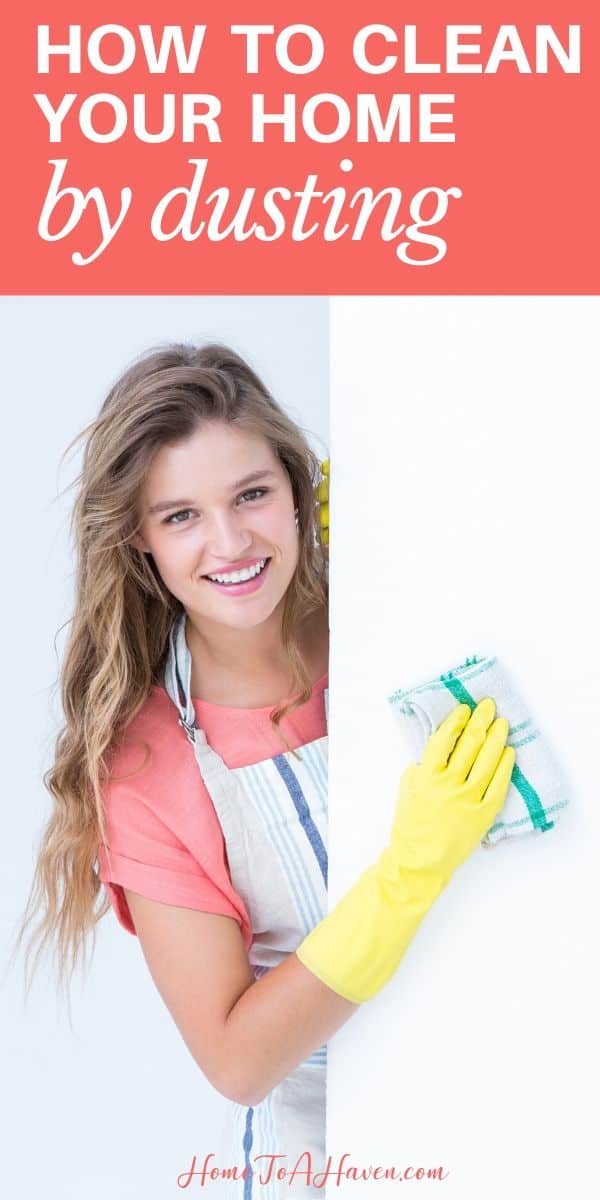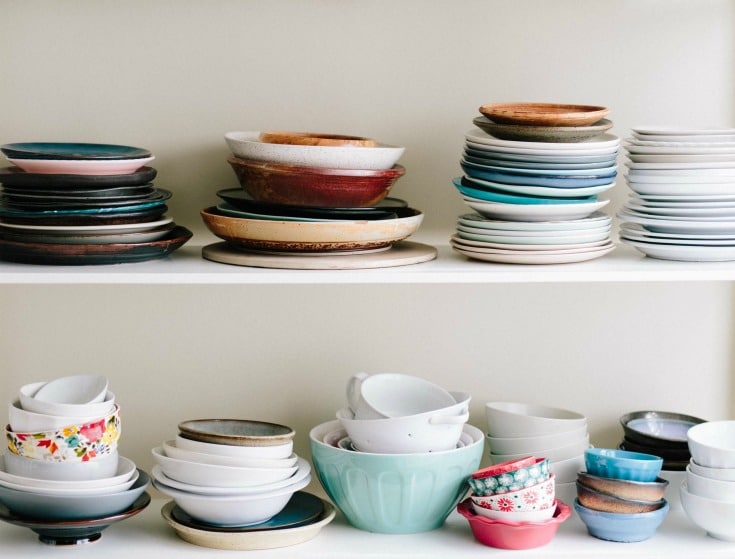How to Clean Your Home By Dusting
Learning the art of dusting isn’t difficult – and it can help you keep your home clean!
Dusting isn’t a difficult chore.
Tedious, yes, but not difficult.
Yet there is a bit of an art of dusting. For example, it’s always good to start at the top and work your way down. That way, if you’re dealing with a really dusty area, all the dust bunnies will float down – and you won’t make your dusted area dirty again.
It’s also great to be a thorough duster. While you could dust around items, be sure to pick things like knick knacks or lamps up as you dust – and dust under them.

Common dusting problems
When learning the art of dusting, a lot of different tools and methods are used. Not all are great, though.
Growing up, I was taught to use an old cloth diaper and an aerosol can of dusting spray.
I later discovered this was not a safe way of dusting – or very effective. First of all, the aerosol dusting sprays are filled with toxic ingredients – and that’s not what I want to have in the air of my home.
Secondly, dusting spray doesn’t remove dust – the dust is pushed into crevices, and the spray adds a coating of chemicals to make the surface look shiny. After you’re finished dusting and the coating evaporates, your surface looks dusty once again – because the dust never was removed.
The trick comes in thoroughly removing the dust.
Once you remove the dust from the surface, it takes a lot longer to look dusty again – and that means you won’t have to dust as frequently.
Tools that I love
Once I knew that most dusting sprays are toxic – and not what I wanted to use in my home – I still wanted to (safely!) dust and polish my hard surfaces. After a lot of trial and error, I found what works best for me.
- The Norwex Dusting Mitt is made of incredibly fine (and fluffy) microfiber. The weave of the microfiber is so tight that it lifts the dust off a surface through an electrostatic charge and then traps it in the microfiber. It’s the best way I’ve found to remove dust from surfaces – and cut down how frequently I need to dust. (Three cheers for that!)When the dust isn’t removed from the surface – and that’s exactly what happens when you use aerosol sprays – you’ll have to keep up with frequent dusting. I also love the dusting mitt because it’s so stinking easy to use. Used to dusting with a cloth and spray, the dusting mitt makes dusting simple because you slip it on your hand, just like a mitten, and wipe your entire hand over flat surfaces. While it doesn’t sound like a big difference, it saves an awful lot of time – and I love time savers when it comes to cleaning! Aside from dusting flat surfaces, I also use my dusting mitt to quickly dust screens in my windows, cold air returns, baseboards, my car’s dashboard, and hardwood stairs. Once the mitt looks pretty filthy, I toss it in the washing machine and dryer with my laundry and it looks good as new.
- For hard-to-reach areas, like where the walls meet the ceiling, I use a couple of tools – the Norwex EnviroWand and the Norwex mop with the dry superior mop pad attached.I use the EnivoWand for areas that are within my reach – or if I’m on a step ladder – and I fully extend the mop for areas that are far out of my reach.
I also use the EnviroWand to dust off blades of ceiling fans, as well as behind my refrigerator and under beds. (It’s super handy when reaching things like toys that are dropped behind the couch.)After years of using a Swiffer dust mop for these cleaning jobs, I always ended up frustrated at how poorly it worked. Either the Swiffer duster would fall off, or the mop wouldn’t go exactly where I wanted it to. This hasn’t happened once I made the Norwex switch – and I’ve been dusting with Norwex for the past three years. - To dust surfaces without Norwex products, I’d suggest using a pre-fold cloth diaper (or a cleaning rag with similar softness) or a feather duster. Since I can’t recommend any dusting sprays, just plan on dusting frequently.
- When it comes to polishing my furniture, I make my own furniture polish out of lemon juice, olive oil, and vinegar. It’s easy. (Just mix together 1/8 cup of lemon juice – squeezing a half a lemon makes this simple and preservative-free — 1/4 cup of olive oil, and a splash of white vinegar.)
Once I’ve dusted my wood furniture, I rub in my homemade polish with an old cloth diaper. Everything shines once again and I’m able to naturally care for my wood furniture.
By using the right tools and dusting from top to bottom, the art of dusting is easy to perfect!
As you’ve been learning the art of dusting, what tricks and tools work well for you?
Disclosure: Purchasing items through links in this post will result in a commission for Home to a Haven. Thank you for supporting this website!
All images courtesy of Pixabay.
- Getting Caught Up with All You Need to Do - February 3
- Welcoming The Tension of Tidy into the World! - January 28
- Becoming Content with Reality in Your Home - January 20










Hi Hilary! I love your website and it is encouraging me to clean and declutter my home. Working on my Haven ????.